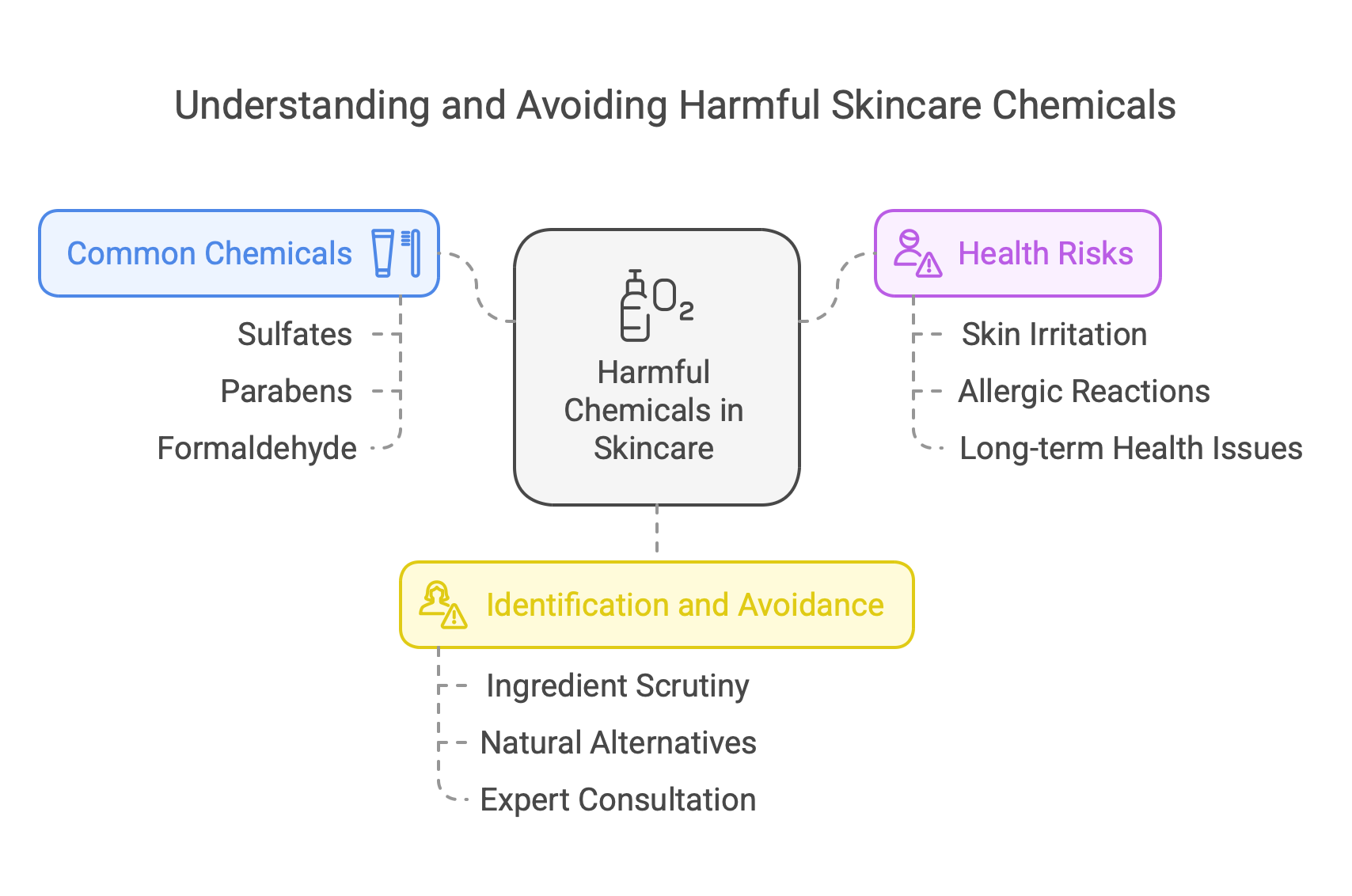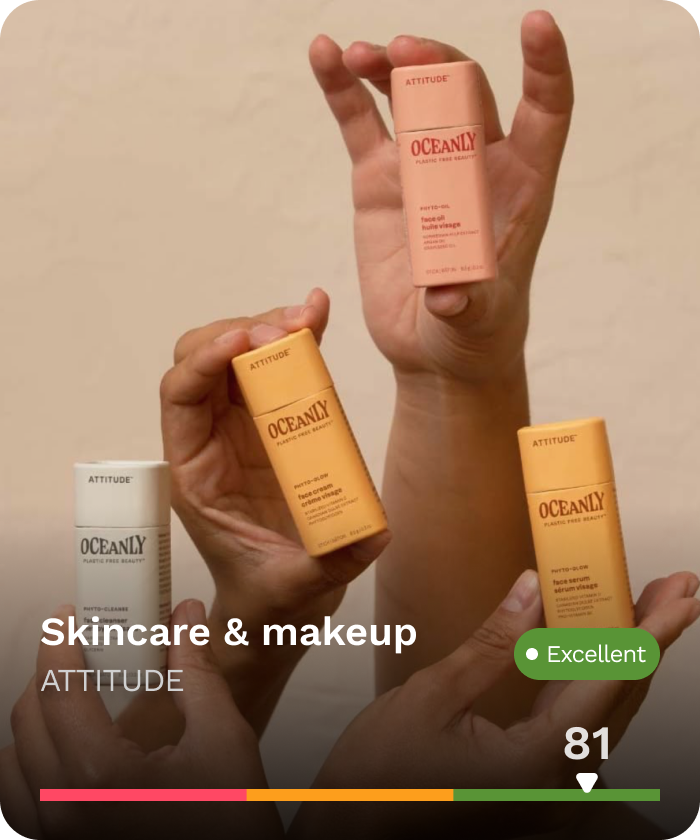[1]: Toxic beauty – Harvard Health
[2]: The Toxic Twelve Chemicals and Contaminants in Cosmetics
[3]: 16 Toxic Chemicals To Avoid In Cosmetics And Skincare
[4]: 12 Harmful Chemicals to Avoid in Your Skincare Routine
[5]: Are Harmful Chemicals Hiding in Your Cosmetics? – WebMD
[6]: Chemicals of Concern – Safe Cosmetics
[7]: 20 Most Toxic Ingredients To Avoid In Skincare
[8]: 20 Most Toxic Ingredients To Avoid In Skincare
[9]: 16 Toxic Chemicals To Avoid In Cosmetics And Skincare
[10]: 12 Common Skincare Ingredients to Avoid, According to Dermatologists
[11]: The Toxic Twelve Chemicals and Contaminants in Cosmetics
[12]: 12 Harmful Chemicals to Avoid in Your Skincare Routine
[13]: The Truth About Skincare: 15 Toxic Ingredients to Avoid
[14]: The Toxic Twelve Chemicals and Contaminants in Cosmetics
[15]: 12 Harmful Chemicals to Avoid in Your Skincare Routine
[16]: 16 Toxic Chemicals To Avoid In Cosmetics And Skincare
[17]: 12 Common Skincare Ingredients to Avoid, According to Dermatologists
[18]: The 14 Toxic Cosmetic Ingredients to Avoid (and How to Find Healthier …
[19]: Chemicals to Avoid: Shampoo, Conditioner, Creams, Cosmetics
[20]: The 14 Toxic Cosmetic Ingredients to Avoid (and How to Find Healthier …
[21]: 12 Harmful Chemicals to Avoid in Your Skincare Routine
[22]: The Truth About Skincare: 15 Toxic Ingredients to Avoid
[23]: 16 Toxic Chemicals To Avoid In Cosmetics And Skincare
[24]: 30 Toxic Chemicals to avoid in Skincare products – ABSTRACTED COLLECTIVE
[25]: 20 Ingredients a Clean Cosmetic Chemist Would Avoid – Byrdie
[26]: 12 Harmful Chemicals to Avoid in Your Skincare Routine
[27]: The 14 Toxic Cosmetic Ingredients to Avoid (and How to Find Healthier …
[28]: Carcinogens in beauty products: Beware of these cancer-causing …
[29]: 16 Toxic Chemicals To Avoid In Cosmetics And Skincare
[30]: Many Common Beauty Products Contain Dangerous Chemicals
[31]: 12 Potentially Toxic Ingredients Found in Beauty Products – The Healthy
[32]: 12 toxic and harmful ingredients in makeup and skincare products you …
[33]: 16 Toxic Chemicals To Avoid In Cosmetics And Skincare
[34]: 12 Harmful Chemicals to Avoid in Your Skincare Routine
[35]: The 14 Toxic Cosmetic Ingredients to Avoid (and How to Find Healthier …
[36]: The Toxic Twelve Chemicals and Contaminants in Cosmetics
[37]: 10 Toxic Skincare Ingredients to Avoid — and Why – Conscious Life & Style
[38]: 25 Dangerous Chemicals Commonly Used In Cosmetics
[39]: Cosmetics compliance: closing regulatory gaps to ensure safety and …
[40]: States Seek Crackdown on Toxic Ingredients in Cosmetics to Close Gaps …
[41]: Regulatory Challenges faced by Cosmetic Companies
[42]: The Impact of Ever-Increasing State Regulation of the Beauty Industry
[43]: Regulatory Insights: Cosmetics Industry Safety and Compliance
[44]: US Beauty Products Are Still Full of Dodgy Ingredients
[45]: Cosmetics Laws & Regulations | FDA
[/et_pb_text][/et_pb_column][/et_pb_row][/et_pb_section]Are your products save?
Download ALVA to check if the products you use regularly are free from dangerous chemicals.
TL;DR
Hidden Dangers in Beauty Products
The average woman uses 12 beauty products daily, many containing chemicals linked to serious health risks like cancer, birth defects, and hormonal disruptions. Common harmful ingredients include:
- Formaldehyde: A carcinogen found in some beauty products.
- Sulfates: Irritate skin and eyes, toxic to aquatic species.
- Parabens: Linked to hormonal disruption and reproductive harm.
- 1,4-Dioxane: A cancer-linked contaminant in sudsing products, not listed on labels.
- Acrylates: Found in nail products, causing skin and eye irritation.
Toxic Ingredients in Skincare Products
Many popular skincare products contain harmful chemicals that can negatively impact health. Common toxic ingredients include:
- Sulfates: Found in lathering products, they irritate skin, strip hair dye, and harm aquatic ecosystems.
- Parabens: Preservatives linked to hormone disruption, reproductive issues, and cancer.
- Formaldehyde: A carcinogen associated with cancer and severe health risks.
Specific Health Risks of Toxic Chemicals in Skincare
Prolonged exposure to toxic chemicals in skincare products poses serious health risks, including:
- Parabens: Mimic estrogen, linked to breast cancer and hormonal disruption.
- Sulfates: Cause skin and eye irritation; contribute to environmental damage through extraction.
- Formaldehyde: A carcinogen causing irritation and allergic reactions.
- Benzene: Found in aerosols, linked to leukemia and blood disorders due to contamination.
Daily use of multiple products exposes individuals to over 150 unique chemicals, which accumulate in the body and may lead to long-term health issues. Consumers are urged to choose products with safer, natural ingredients to reduce these risks.
Identifying and Avoiding Harmful Chemicals in Skincare
To protect your skin and health from harmful chemicals like sulfates, parabens, and formaldehyde:
- Identify Harmful Chemicals: Learn to recognize common toxic ingredients and avoid products containing them. Check ingredient lists for substances like formaldehyde and parabens, and be aware of regulatory gaps (e.g., EU bans vs. U.S. approval).
- Educate Yourself: Keep a list of harmful ingredients (e.g., the “toxic twelve”) and research products with natural, plant-based alternatives.
- Consult Experts: Cosmetic chemists can provide valuable advice on which ingredients to avoid.
- Stay Informed: Regularly update yourself on new research in the skincare industry.
- Choose Natural Alternatives: Opt for non-toxic, organic skincare brands to minimize exposure to harmful substances.
Regulatory Issues and Gaps in the Cosmetic Industry
-
Major Gaps: The cosmetic industry faces inconsistent regulations across regions. The EU has stricter regulations than the U.S., which has outdated laws. The U.S. FDA primarily conducts post-market surveillance, allowing potentially harmful products to enter the market without pre-approval.
-
MoCRA Limitations: The Modernization of Cosmetics Regulation Act (MoCRA) in the U.S. addresses some gaps but lacks comprehensive ingredient safety and transparency measures.
-
Regulatory Gaps in Safety: Laws like the Federal Food, Drug, and Cosmetic Act and the Fair Packaging and Labeling Act require ingredient listing but do not mandate pre-market approval for cosmetics. The Microbead-Free Waters Act of 2015 addresses microbeads but overlooks other harmful chemicals.
-
Solutions: To improve safety, the FDA could gain more authority to approve ingredients before products hit the market. Strengthening labeling requirements and expanding evaluations of harmful substances would help protect consumers.
Introduction
The average woman uses 12 different beauty products daily, which include cleansers,
conditioners, hair dyes, fragrances, skin care products, scented lotions, nail polish,
and makeup[1][5]. These products often contain a complex mixture of chemical ingre-
dients that have not all been tested for long-term safety[1]. The lack of rigorous testing
and government oversight in the cosmetics industry means that many potentially
harmful chemicals are present in everyday skincare products[2].
Exposure to certain chemicals in cosmetics has been linked to significant health risks,
including cancer, birth defects, and reproductive harm[2]. For instance, formalde-
hyde, a known carcinogen, is one such chemical that is found in some beauty
products[2][4]. Other harmful ingredients include sulfates, which can irritate the skin
and eyes and are toxic to aquatic species when washed away[3]. Parabens, another
common ingredient, have been associated with hormonal disruptions and potential
reproductive harm[3][4].
Notably, 1,4-dioxane, a contaminant linked to cancer, is not listed on ingredient labels
but can be found in products that create suds, such as shampoos and liquid soaps[6].
Similarly, acrylates used in artificial nail products can cause adverse reactions to
the skin, eyes, and throat[6]. The absorption of metals through the skin from these
products can lead to internal organ damage over time[5].
Consumers often assume that their cosmetics are tested for safety, but this is not
the case. The FDA does not pre-approve cosmetics or their ingredients, except for
color additives, and generally only steps in when consumer complaints arise[5]. This
lack of pre-market safety testing underscores the need for increased awareness and
regulation to mitigate the risks posed by these dangerous chemicals in skincare
products.
ALVA Favourites
When you make a purchase through retailer links on our site, we may earn commission through affiliate programs. All affiliate fees ALVA receives support our mission. Learn more here
Are your products safe?
Scan your products now with the ALVA app to get a personalised risk analysis.

Toxic Ingredients in Skincare Products
Many skincare products on the market contain ingredients that can be harmful to
your health[7]. Growing up, bath and body products were highly popular, and many
people, including myself, used a wide range of these items—from bath splashes
to hair products—without understanding the potential dangers they posed[7]. The
realization of the toxic chemicals in these products often comes later, leaving many
to regret the uninformed choices they made in their youth[7].
To help individuals make safer, healthier choices for their skin, it is essential to be
aware of the key toxic ingredients to avoid[7]. By identifying these harmful sub-
stances, consumers can opt for cleaner, more natural alternatives in their skincare
routines[7].
Common Harmful Chemicals in Skincare Products
Many skincare products on the market today contain harmful chemicals that pose
significant health risks. Some of the most common toxic ingredients include sulfates,
parabens, and formaldehyde.
Sulfates are salts derived from sulfuric acid and are commonly used in cosmetics for
their lathering properties. These compounds can irritate the skin and eyes and may
prematurely strip hair dye. Additionally, deriving sulfates from natural sources like
palm oil contributes to environmental destruction, such as rainforest deforestation,
and poses a threat to aquatic life when washed away[9][16].
Parabens are preservatives used to extend the shelf life of cosmetics. They have
been linked to hormone disruption, which can contribute to reproductive issues and
increase the risk of cancer[10][13].
Formaldehyde, a known carcinogen, is another harmful chemical found in some
skincare products. Exposure to formaldehyde has been linked to cancer and other
serious health conditions[11][14].
Understanding these harmful ingredients is crucial for making safer choices about
skincare products. Awareness has increased recently, leading many consumers to
seek cleaner, more natural alternatives[12][15].
Specific Health Risks Associated with Toxic Chemicals
Prolonged exposure to harmful chemicals commonly found in skincare products can lead to a variety of adverse health effects. Ingredients such as parabens, sulfates, and formaldehyde have been linked to skin irritation, allergic reactions, and even long-term health issues such as cancer and endocrine disruption[26]. Parabens, for example, are widely used as preservatives in cosmetics and personal care products. They can mimic estrogen in the body and have been associated with an increased risk of breast cancer[27]. Sulfates, which are often used for their lathering properties, can cause skin and eye irritation and have been debated for their potential environmental impact due to the destruction of rainforests for their extraction from natural sources[29]. Formaldehyde, a known carcinogen, is sometimes used in small amounts in various beauty products and can cause irritation and allergic reactions upon prolonged exposure[26]. Moreover, many personal care products contain benzene, a cancer-causing chemical found in products such as deodorant sprays, dry shampoos, and sunscreens[30]. Although benzene is not an intended ingredient in these products, it may be present due to contamination during the manufacturing process or from the propellants used in aerosol sprays. Chronic exposure to benzene has been linked to leukemia and other blood disorders[30]. The cumulative effect of using multiple products daily, each containing numerous potentially harmful ingredients, raises significant health concerns. On average, a person uses 9 to 15 personal care products daily, which means they could be exposed to over 150 unique chemical ingredients each day[28]. Given the skin’s ability to absorb these chemicals, this consistent exposure can lead to an accumulation of toxic substances in the body over time, potentially causing long-term health problems[32]. As the regulation of cosmetic products remains lax, with agencies like the FDA being criticized for not adequately protecting consumers, it is crucial for individuals to be aware of the ingredients in their skincare products and make informed choices[27 ][28]. By avoiding products with harmful chemicals and opting for those with safer, natural alternatives, consumers can mitigate the health risks associated with toxic chemical exposure.
Identifying and Avoiding Harmful Chemicals
How to Identify Harmful Chemicals in Skincare Products
Understanding how to identify harmful chemicals in skincare products is essential for
maintaining healthy skin and overall well-being. The presence of ingredients like sul-
fates, parabens, and formaldehyde in many skincare products has raised significant
health concerns. Sulfates, which are commonly used as surfactants to create lather,
can irritate the eyes and skin, and contribute to environmental damage when derived
from sources like palm oil[33]. Parabens, widely used as preservatives, have been
linked to hormonal disruptions and an increased risk of certain cancers[34].
The Food and Drug Administration (FDA) regulates cosmetics and personal care
products in the United States but is criticized for its inadequate oversight. This situ-
ation places the onus on consumers to scrutinize product ingredients carefully[35].
It’s advisable to carry a list of harmful chemicals, such as the “toxic twelve” that
include known carcinogens like formaldehyde, and avoid products containing these
substances[36]. Moreover, awareness is crucial as many harmful chemicals, banned
in the European Union, are still allowed in U.S. products, highlighting a regulatory
gap that consumers need to navigate[37].
To make informed choices, it is beneficial to research and opt for products that
use natural alternatives to harmful synthetic chemicals[35]. For instance, instead of
products with alpha hydroxy acids (AHA) which can be harsh on the skin, look for
skincare items that use gentler, plant-based ingredients[38]. Prioritizing non-toxic and
organic skincare brands can also mitigate exposure to harmful substances, ensuring
safer daily skincare routines[37].
Steps to Avoid Dangerous Chemicals in Skincare Products
Understanding the ingredients in your skincare products is essential to maintaining
healthy skin and avoiding potential health risks. One of the most effective steps
consumers can take is to educate themselves on harmful chemicals commonly found
in cosmetics and skincare products. Ingredients such as parabens, sulfates, and
formaldehyde have been linked to various health issues, including skin irritation,
allergic reactions, and even long-term damage like cancer and reproductive toxic-
ity[21][22][23].
To start, scrutinize the ingredient list on the products you use. While this may seem
daunting due to the often long and complex names, it is crucial for identifying harmful
substances. Consumers are advised to keep a list of ingredients to avoid and to refer
to it while shopping for new products[20][24]. This can help you make more informed
choices and steer clear of products containing toxic chemicals.
It’s also beneficial to seek out natural alternatives that perform similarly to their
synthetic counterparts without the associated health risks. Natural ingredients can
be just as effective and are typically less harmful to your skin and overall health[20].
Consulting experts, such as cosmetic chemists, can provide valuable insights into
which ingredients to avoid and why. They can help dispel some of the misinformation
surrounding skincare products and offer evidence-based recommendations[25].
Moreover, it’s important to stay informed about new research and updates in the skin-
care industry. The field is constantly evolving with new scientific findings, which can
help you make better decisions about the products you use[25]. Finally, remember
that individual reactions to ingredients can vary, so it’s crucial to find what works best
for your skin specifically[25].
By taking these proactive steps, you can significantly reduce your exposure to
harmful chemicals and protect your skin’s health.
Regulatory Issues and Gaps
Major Regulatory Gaps in the Cosmetic Industry
The cosmetic industry faces several major regulatory gaps that contribute to the
presence of harmful chemicals in skincare products. One significant gap is the
inconsistent and often inadequate regulatory frameworks across different regions.
For instance, the European Chemicals Agency (ECHA) has identified the presence
of hazardous chemicals in cosmetic products through inspections, highlighting reg-
ulatory gaps in compliance with REACH and the EU Cosmetic Products Regulation
(CPR)[39]. In contrast, the United States has lagged behind in updating its chemical
regulations, leaving a void that allows potentially toxic products to remain on the
market[40]. This inconsistency is compounded by the diverse regulations across the
world’s top cosmetic markets, each with unique importation processes and control
over ingredients, labeling, and packaging[41].
The recent enactment of the Modernization of Cosmetics Regulation Act (MoCRA) in
the U.S. attempted to address some of these issues by updating the FDA’s oversight
of cosmetics for the first time since 1938. However, industry experts argue that
MoCRA falls short, especially regarding ingredient safety and transparency[42]. The
FDA’s role in regulating cosmetics primarily involves post-market surveillance rather
than pre-market approval, which is more stringent in the pharmaceutical industry[43].
This difference means that cosmetics can enter the market without rigorous safety
evaluations, relying instead on post-market actions to address safety concerns[44].
Efforts by individual states, such as Washington, to crack down on toxic substances
in cosmetics illustrate the fragmented approach to regulation within the U.S.[40].
This patchwork of state-level actions underscores the need for a more cohesive
and comprehensive regulatory framework to effectively manage the risks posed by
harmful chemicals in skincare products.
Regulatory Issues in Skincare Products Safety
Regulatory oversight of skincare products in the United States involves several key
laws enforced by the FDA, including the Federal Food, Drug, and Cosmetic Act, the
Modernization of Cosmetics Regulation Act of 2022, the Fair Packaging and Labeling
Act, and the Microbead-Free Waters Act of 2015[45]. These laws are designed to
ensure that cosmetics are safe for use and properly labeled. However, there are
significant regulatory gaps that contribute to the presence of harmful chemicals in
skincare products.
One notable regulation is the requirement for cosmetics to be labeled in accordance
with the Fair Packaging and Labeling Act, which mandates that ingredients be listed
on product labels[45]. Despite this, the FDA does not have the authority to approve
cosmetics before they go on the market, which can lead to the introduction of
potentially harmful substances. Moreover, regulations from Title 21 of the Code of
Federal Regulations (21 CFR) cover various aspects of cosmetics, but they do not
comprehensively address all safety concerns[45].
Additionally, while the Microbead-Free Waters Act of 2015 addresses environmental
concerns related to microbeads in rinse-off cosmetics, its scope is limited to specific
products and does not encompass a broader range of harmful chemicals[45]. The
effective dates for compliance with this act were staggered, with manufacturing
deadlines in 2017 and 2018, and interstate commerce deadlines in 2018 and 2019,
indicating a phased approach to regulation[45].
To mitigate these regulatory gaps, increased authority for the FDA to review and
approve cosmetic ingredients before they are marketed could be a significant step
forward. Strengthening labeling requirements and ensuring that all potentially harmful
substances are thoroughly evaluated would also contribute to better consumer
protection and safer skincare products[45].
REFRENCES:
[1]: Toxic beauty – Harvard Health
[2]: The Toxic Twelve Chemicals and Contaminants in Cosmetics
[3]: 16 Toxic Chemicals To Avoid In Cosmetics And Skincare
[4]: 12 Harmful Chemicals to Avoid in Your Skincare Routine
[5]: Are Harmful Chemicals Hiding in Your Cosmetics? – WebMD
[6]: Chemicals of Concern – Safe Cosmetics
[7]: 20 Most Toxic Ingredients To Avoid In Skincare
[8]: 20 Most Toxic Ingredients To Avoid In Skincare
[9]: 16 Toxic Chemicals To Avoid In Cosmetics And Skincare
[10]: 12 Common Skincare Ingredients to Avoid, According to Dermatologists
[11]: The Toxic Twelve Chemicals and Contaminants in Cosmetics
[12]: 12 Harmful Chemicals to Avoid in Your Skincare Routine
[13]: The Truth About Skincare: 15 Toxic Ingredients to Avoid
[14]: The Toxic Twelve Chemicals and Contaminants in Cosmetics
[15]: 12 Harmful Chemicals to Avoid in Your Skincare Routine
[16]: 16 Toxic Chemicals To Avoid In Cosmetics And Skincare
[17]: 12 Common Skincare Ingredients to Avoid, According to Dermatologists
[18]: The 14 Toxic Cosmetic Ingredients to Avoid (and How to Find Healthier …
[19]: Chemicals to Avoid: Shampoo, Conditioner, Creams, Cosmetics
[20]: The 14 Toxic Cosmetic Ingredients to Avoid (and How to Find Healthier …
[21]: 12 Harmful Chemicals to Avoid in Your Skincare Routine
[22]: The Truth About Skincare: 15 Toxic Ingredients to Avoid
[23]: 16 Toxic Chemicals To Avoid In Cosmetics And Skincare
[24]: 30 Toxic Chemicals to avoid in Skincare products – ABSTRACTED COLLECTIVE
[25]: 20 Ingredients a Clean Cosmetic Chemist Would Avoid – Byrdie
[26]: 12 Harmful Chemicals to Avoid in Your Skincare Routine
[27]: The 14 Toxic Cosmetic Ingredients to Avoid (and How to Find Healthier …
[28]: Carcinogens in beauty products: Beware of these cancer-causing …
[29]: 16 Toxic Chemicals To Avoid In Cosmetics And Skincare
[30]: Many Common Beauty Products Contain Dangerous Chemicals
[31]: 12 Potentially Toxic Ingredients Found in Beauty Products – The Healthy
[32]: 12 toxic and harmful ingredients in makeup and skincare products you …
[33]: 16 Toxic Chemicals To Avoid In Cosmetics And Skincare
[34]: 12 Harmful Chemicals to Avoid in Your Skincare Routine
[35]: The 14 Toxic Cosmetic Ingredients to Avoid (and How to Find Healthier …
[36]: The Toxic Twelve Chemicals and Contaminants in Cosmetics
[37]: 10 Toxic Skincare Ingredients to Avoid — and Why – Conscious Life & Style
[38]: 25 Dangerous Chemicals Commonly Used In Cosmetics
[39]: Cosmetics compliance: closing regulatory gaps to ensure safety and …
[40]: States Seek Crackdown on Toxic Ingredients in Cosmetics to Close Gaps …
[41]: Regulatory Challenges faced by Cosmetic Companies
[42]: The Impact of Ever-Increasing State Regulation of the Beauty Industry
[43]: Regulatory Insights: Cosmetics Industry Safety and Compliance
[44]: US Beauty Products Are Still Full of Dodgy Ingredients
Are your products save?
Download ALVA to check if the products you use regularly are free from dangerous chemicals.

